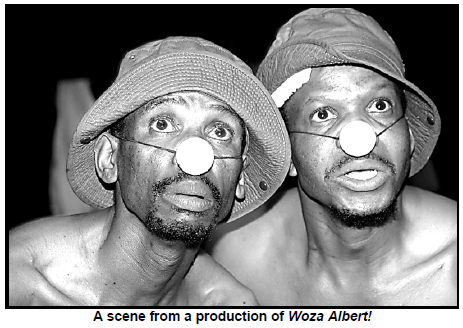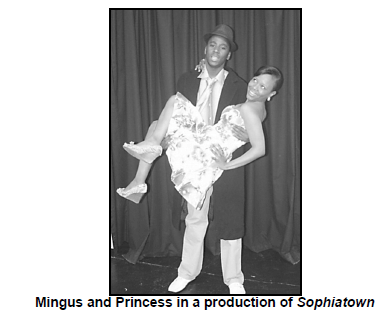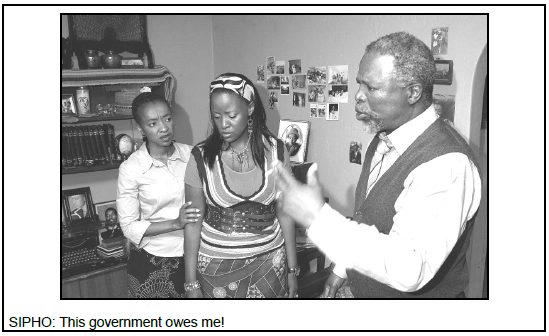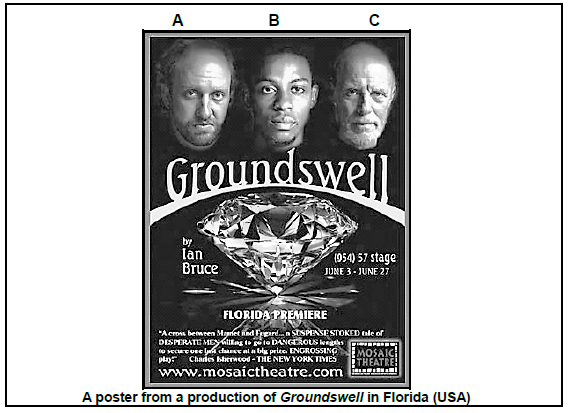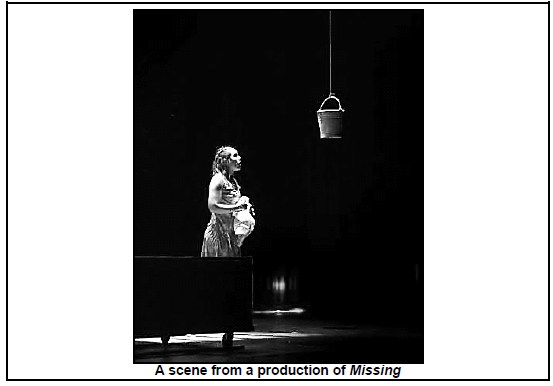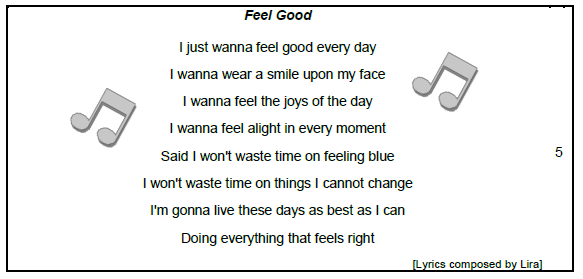DRAMATIC ARTS Past Paper FEBRUARY/MARCH 2016 - GRADE 12 NATIONAL SENIOR CERTIFICATE
Share via Whatsapp Join our WhatsApp Group Join our Telegram GroupDRAMATIC ARTS
FEBRUARY/MARCH 2016
MARKS: 150
TIME: 3 hours
INSTRUCTIONS AND INFORMATION
- This question paper consists of FOUR sections:
SECTION A: 20th Century Theatre Movements (30)
SECTION B: South African Theatre: 1960–1994 (40)
SECTION C: South African Theatre: Post-1994 – Contemporary (40)
SECTION D: The History of Theatre, Practical Concepts, Content and Skills (40) - SECTION A
QUESTION 1 is COMPULSORY.
Refer to the play text you have studied and its relevant 20th Century Theatre Movement.
EPIC THEATRE- Caucasian Chalk Circle Bertolt Brecht
- Kaukasiese Krytsirkel Translation of Bertolt Brecht play text
- Mother Courage Bertolt Brecht
- Moeder Courage Translation of Bertolt Brecht play text
- The Good Person of Szechwan Bertolt Brecht
- Kanna Hy Kô Hystoe Adam Small
OR
THEATRE OF THE ABSURD - Waiting for Godot Samuel Beckett
- Afspraak met Godot Translation of Samuel Beckett play text
- Bagasie André P Brink
- The Bald Primadonna Eugene Ionesco
- Die Kaalkop Primadonna Translation of Eugene Ionesco play text
OR
POSTMODERN THEATRE - Skrapnel Willem Anker
- Top Girls Carol Churchill
- Popcorn Ben Elton
- Buried Child Sam Shepard
- SECTION B
This section consists of THREE questions. Answer only ONE question in this section.
QUESTION 2: Woza Albert! Percy Mtwa, Mbongeni Ngema and Barney Simon, OR
QUESTION 3: Sophiatown Junction Avenue Theatre Company, OR
QUESTION 4: Siener in die Suburbs PG du Plessis - SECTION C
This section consists of THREE questions. Answer only ONE question in this section.
QUESTION 5: Nothing but the Truth John Kani, OR
QUESTION 6: Groundswell Ian Bruce, OR
QUESTION 7: Missing Reza de Wet - SECTION D
This section consists of TWO questions. Both are COMPULSORY.
SECTION A: 20th CENTURY THEATRE MOVEMENTS
This question is COMPULSORY.
QUESTION 1
Refer to the play text you have studied and its relevant 20th Century Theatre Movement (Theatre of the Absurd OR Epic Theatre OR Postmodern Theatre).
Study SOURCE A below and answer the question that follows.
SOURCE A
| I think what makes people fascinating is conflict. It's drama, it's the human condition. Nobody wants to watch perfection. – Nicolas Cage |
Discuss in an essay the imperfection of the human condition as reflected in the play text you studied.
Refer to any FOUR of the following:
- Sociopolitical context
- Themes
- Characters
- Language and dialogue
- Space and set
- Plot and structure
- Theatrical devices
Indicate at the top of your essay which play text you studied.
TOTAL SECTION A: 30
SECTION B: SOUTH AFRICAN THEATRE: 1960–1994
Answer only ONE question in this section.
QUESTION 2: WOZA ALBERT! BY PERCY MTWA, MBONGENI NGEMA AND BARNEY SIMON
Study SOURCE A below and answer the questions that follow.
SOURCE A
You have been chosen to direct a school production of Woza Albert! at your school. Use SOURCE A to guide the planning and preparation of your play.
2.1 State what the ping-pong ball noses represent in the play. (2)
2.2 The use of the ping-pong ball noses is an example of satire.
2.2.1 Define the term satire. (2)
2.2.2 Explain how satire is used in any TWO scenes in the play. (6)
2.3 Describe how the actors could use sound effects to create the environment (images/objects/settings) of the play. (4)
2.4 SOURCE A: How do the actors physically show that they are looking at the same imaginary object/person? (2)
2.5 As a director, motivate the physical skills the actor would need in order to meet the performance demands of Woza Albert!. (6)
2.6 Describe a suitable exercise to assist the actors in Woza Albert! to focus and concentrate while performing. (2)
2.7 Justify whether the play could be performed by female actors. Motivate your response. (4)
2.8
| The word 'theatre' comes from Greek. It means 'the seeing place'. It is the place where people go to see the truth about life and the social situation. The theatre is a spiritual and social X-ray of its time. The theatre was created to tell people the truth about life and the social situation. – Stella Adler |
Discuss how Woza Albert! could be described as a 'spiritual and social X-ray of its time … to tell people the truth about life and the social situation'.
Refer to FOUR examples from the play text to support your answer. (12)
[40]
QUESTION 3: SOPHIATOWN BY THE JUNCTION AVENUE THEATRE COMPANY
Study the sources below and answer the questions that follow.
SOURCE B
| MINGUS: Tell her I only go for the best. JAKES: How do you know it's the best? MINGUS: Easy, man – check the labels! Only genuine English or American imports, 'Can't-gets' – Florsheims, Winthrops, Bostonians, Saxone and Manfield, Arrow shirts, suits from Simpson's, Hector Powe, Robert Hall, Dobbs, Woodrow, Borsalino hats. You tell her I'm the best dresser in town. American straights. You tell her I'm a smart guy – no messing around, and I want her here at six o'clock! |
SOURCE C
You are the director of a school production of this play.
3.1 Describe and motivate your costume choices for the characters of Mingus and Princess. Refer to SOURCE B and SOURCE C. (4)
3.2 Describe to the actors playing Mingus and Princess, the glamour and romance of their characters and their relationship. (4)
3.3 Explain how the glamour and romance of Mingus and Princess's relationship contrast with the reality of their situation. (3)
3.4 Give instructions on how you would direct the actors playing Mingus and Princess to portray their characters physically. Refer to the play text as a whole. (6)
3.5 Motivate how you would depict the reality of life in Sophiatown through your selection of set and props. (6)
3.6 The original production of Sophiatown used signs and slogans as a backdrop to the action. You want to create a similar visual effect.
Suggest ONE appropriate slogan you could choose to use on stage. (1)
3.7 Discuss the theatrical effectiveness of the use of slogans in a production of Sophiatown. (4)
3.8
| Sophiatown is the past we cannot forget. – Amos Masondo |
Discuss how the play Sophiatown represents the past (history) of Sophiatown, the place.
Refer to your knowledge of the play as a whole in your answer. (12)
[40]
QUESTION 4: SIENER IN DIE SUBURBS BY PG DU PLESSIS
Study SOURCE D below and answer the questions that follow.
SOURCE D
| TIEMIE:Ek was te bang vir jou. Ek is nie meer bang vir jou nie. Maak my vrek, ek trou nie met jou nie, en jou kleintjie sal ek regsien. Loop! Ek het genoeg gehad van jou en van die Suburbs en van Ma en van die hele bleddie boel. Loop! Ek wil nie 'n tang hê nie. Ek kan kots van julle almal. Maak my vrek, jy sal my nie hier hou nie. Ek gaan na die dandies toe. Jy's 'n tang! 'n Tang! 'n Tang! 5 JAKES: Ek sal jou nie los nie! TIEMIE: Ek wil jou nie hê nie. JAKES: Oor jy dink ek's 'n tang dink jy ek het nie insides nie? Sê vir my tang! Jy't nie tang gesê toe jy by my lê nie. Dink jy ek't nie love nie. Dink jy ek het nie geworry oor daardie dandies nie? Dink jy … dink jy ek het nie gevoel oor jou nie … Die tang … Ek sal jou nie vir die dandies gee nie … 10 MA: Jakes, los my kind … Tjokkie, help! (Tiemie ruk los en hardloop die huis binne. Giel, sy tas gepak, loop teen haar vas, dan teen Jakes.) JAKES: Jy sal nie ok weg kom nie. Ek sal jou hê … 15 MA: Giel, help my, hy gaan vir Tiemie doodmaak. GIEL: (ruk hom los) Sorry, my meisie … MA: Giel! (Hy stap oor die verhoog en af.) 20 GIEL: (mompel) Sorry, man, hel sorry, sorry, ou girl … |
You are the director of a production of Siener in die Suburbs in your local community hall. Use the extract above and your knowledge of the play to guide your answers.
4.1 Advise the actress who plays Tiemie on how to achieve the most effective vocal and physical performance of her lines (1–6) to show her increasing desperation. (6)
4.2 Explain to the actress playing Tiemie why, at this point in the play, she is no longer scared of Jakes. (2)
4.3 What does Tiemie mean when she says that she is going to the 'dandies'? (2)
4.4 Suggest what this extract reveals about Giel's character. You may refer to the play as a whole in your answer. (4)
4.5 Motivate to your costume designer why Ma and Tiemie's costumes should be different in the play. (6)
4.6 Identify, with a reason, the stage type you would need for a production of Siener in die Suburbs. (2)
4.7 Describe to your set designer the set you would require for your production. Substantiate your choices with reference to the play text. (6)
4.8 Siener in die Suburbs – like so many stories – is really about love or, in this case, unrequited (one-sided/unreturned) love.
Discuss the theme of 'unrequited love' as demonstrated by the characters in the play. (12)
[40]
TOTAL SECTION B: 40
SECTION C: SOUTH AFRICAN THEATRE: POST-1994 – CONTEMPORARY
Answer only ONE question in this section.
QUESTION 5: NOTHING BUT THE TRUTH BY JOHN KANI
Study SOURCE E below and answer the questions that follow.
SOURCE E
SOURCE E: You are cast as Sipho.
5.1 Give a character description of Sipho. (4)
5.2 Explain how you would express Sipho's emotions vocally and physically when you deliver the line: 'This government owes me!' (4)
5.3 Identify, with reasons, how the photograph reflects the realistic genre of the play. (6)
5.4 Motivate how the blocking (stage positioning) of this scene shows the relationship between the characters. (4)
5.5
| The past is dead. We must give it an appropriate funeral and move on to new and exciting things, springing from the lungs of freedom. – John Kani |
5.5.1 Explain the 'new and exciting things' the character of Sipho experiences in the play through his choice to bury the past and move on. (6)
5.5.2 What is the value of applying John Kani's statement to everyday life? (4)
5.6
| Nothing but the Truth is a play that tells a story that is, in a way, a personal and political, a private and public catharsis (release) for Sipho and for the audiences who watch the play. |
Discuss the validity of the statement above by considering Sipho's personal journey towards truth and reconciliation.(12)
[40]
QUESTION 6: GROUNDSWELL BY IAN BRUCE
Study SOURCE F below and answer the questions that follow.
SOURCE F
You have been chosen to direct a production of Groundswell at your school.
6.1 Identify the characters labelled A, B and C. (3)
6.2 Explain to the actors the function of each of the characters in the development of the plot. (6)
6.3 Give instructions on how you would direct the three actors to portray their characters vocally and physically. Refer to the play text as a whole. (6)
6.4 Discuss how a typical realistic production of Groundswell would be staged. (4)
6.5 Explain how the sociopolitical environment of the play affects the relationships between the characters. (4)
6.6 Explain why the image of a diamond would be suitable to symbolise the central themes of the play. (5)
6.7
| A cross between Mamet and Fugard … a SUSPENSE-STOKED tale of DESPERATE MEN willing to go to DANGEROUS lengths to secure one last chance at a big prize. ENGROSSING play! – Charles Isherwood, The New York Times |
Discuss Charles Isherwood's comments that Groundswell is a 'SUSPENSE- STOKED tale of DESPERATE men willing to go to DANGEROUS lengths to secure one last chance at a big prize'.
Refer to your knowledge of the play as a whole in your answer.
(12)
[40]
QUESTION 7: MISSING BY REZA DE WET
Study the sources below and answer the questions that follow.
SOURCE G
| CONSTABLE:I'm just asking, ma'am. (Suddenly firm.) Please answer my question: is there a loft entrance? MIEM: Yes, there is. And so what? He locked it from the inside. That door has not been opened for seven years! CONSTABLE: So, he has the key? 5 MIEM: Just what are you trying to say, Constable? Do you think my husband is a suspect? My poor Gabriel, who wouldn't hurt a fly! We open our house to you and this is how you repay us! CONSTABLE: Forgive me ma'am … I didn't mean … MIEM: You must think we are stupid. Pretending to protect us! (She snorts.) 10 GERTIE: Aag, come on, Miem. MIEM: Yes, pretending to protect us. But what he really wants to do is snoop around my house! Like a bloodhound. CONSTABLE: Ma'am, I assure you … MIEM: Gabriel is a good man! A sweet, mild man! Upright and honest! From an excellent family! He's 15 always been … a bit moody, but what's wrong with that? Does it make him a monster? Oh, yes I know what people say about him … that he's not … quite right up here. Gossips! Troublemakers! And you believe them! Constable, I think that you had better leave. You are no longer welcome in my house! 20 |
SOURCE H
You have been chosen to stage a production of Missing at your school. Use SOURCE G and SOURCE H to guide the planning and preparation of your play.
7.1 SOURCE G: As a director, explain who Gabriel is to the actor. (1)
7.2 Line 18: Suggest to the actor why people might say of Gabriel 'that he's not … quite right' up here. (3)
7.3 Explain the irony when Miem says to Constable that he is 'pretending to protect' them. (2)
7.4 Motivate how an actor may use any TWO of Stanislavski's methods/techniques to prepare for the role of Miem. (6)
7.5 SOURCE G: Describe how an actor playing Miem would deliver lines 15–20 vocally. (6)
7.6 SOURCE H: Explain how the slop bucket is central to the action in the play. (6)
7.7 SOURCE H: Discuss the technical challenges a director would experience when staging this scene. (4)
7.8
| Paul Boekkooi refers to Missing as an 'essential theatre experience' – the text is loaded with references to sound, smell and touch, and eventually, the magical realism of the sixth sense. |
Discuss the above analysis of Missing by Paul Boekkooi. Refer to your knowledge of the play as a whole in your answer.(12)
[40]
TOTAL SECTION C: 40
SECTION D: THE HISTORY OF THEATRE, PRACTICAL CONCEPTS, CONTENT AND SKILLS
Answer ALL the questions in this section.
QUESTION 8
8.1 Define Realism as a theatrical movement. (2)
8.2 Explain the various features of a realistic play. You may refer to any realistic play that you have studied or seen. (8)
8.3 Define and discuss the features of any TWO of the following 20th century philosophies/theatrical movements (-isms) that you have studied this year:
- Constructivism
- Dadaism
- Existentialism
- Expressionism
- Futurism
- Surrealism
- Symbolism(10)
[20]
QUESTION 9
Study SOURCE I below and answer the questions that follow.
SOURCE I
You have been given the opportunity to use Lira's inspirational lyrics from Feel Good, for a Freedom Day performance at your school.
9.1 Motivate which ONE of the following dramatic forms you would choose for your performance:
- Monologue
- Choral verse
- Physical theatre
- Multimedia (3)
9.2 Based on your choice in QUESTION 9.1, describe the type of stage you would choose in terms of the desired actor-audience relationship. (3)
9.3 Explain the theatrical elements (lighting, sound effects, costumes, et cetera) you may use to create your performance. Refer to specific lines in SOURCE I to explain your choices. (6)
9.4 Write a speech in which you offer advice to the Grade 11 Dramatic Arts class that will assist them in their preparation for their final practical examination.
Include the following in your speech:
- Choice of pieces
- Rehearsals
- Warm-ups
- Vocal and physical interpretative skills (8)
[20]
TOTAL SECTION D: 40
GRAND TOTAL: 150
